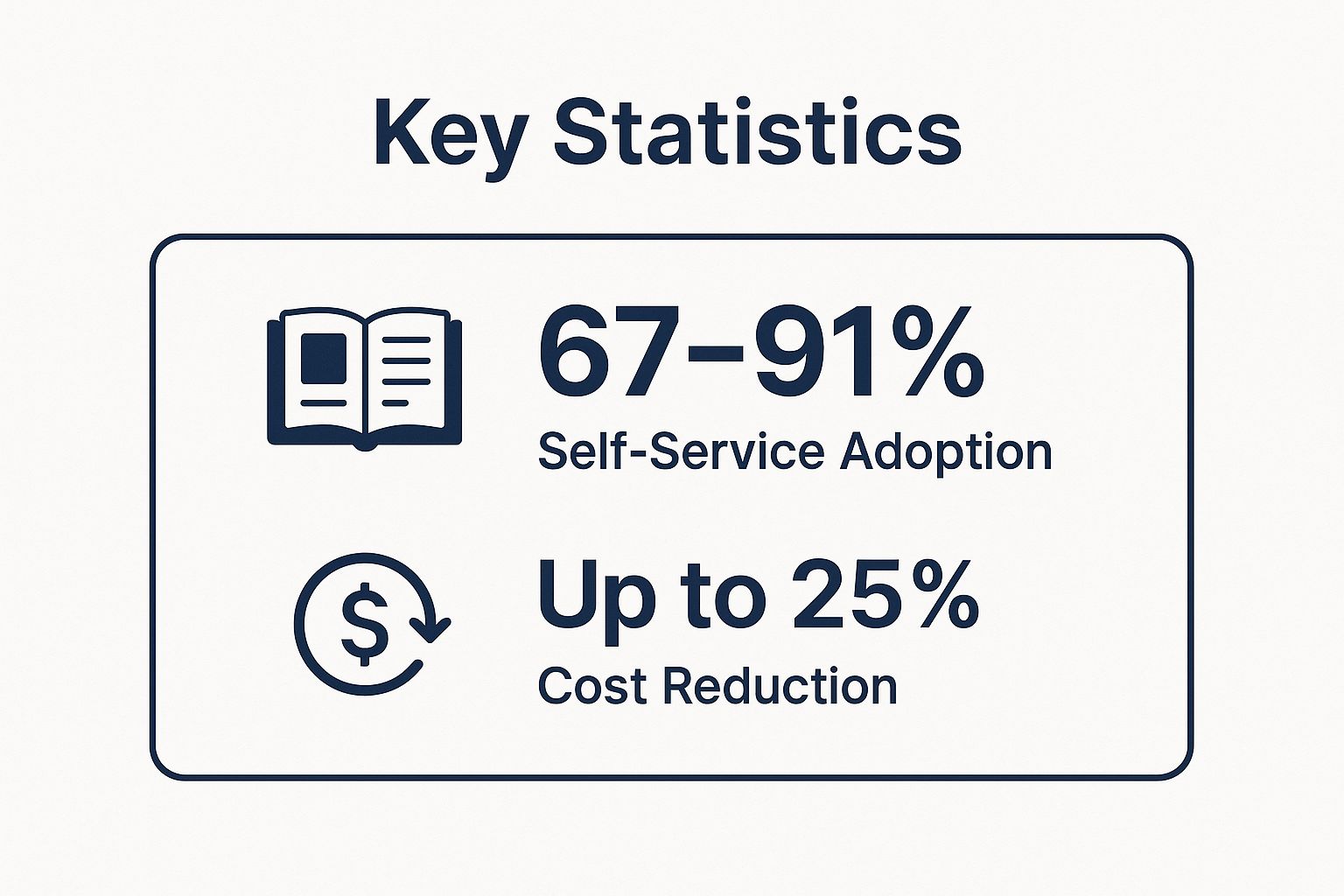In today's competitive landscape, customer expectations are higher than ever. It's no longer enough to simply resolve issues; businesses must create memorable, seamless, and personalized experiences that build lasting loyalty. Adopting proven customer support best practices is the key to transforming your support team from a cost center into a powerful revenue driver. This isn't just about managing complaints, it's about building a reputation for excellence that sets you apart.
Exceptional service directly impacts your bottom line. When customers feel valued and understood, they are more likely to return, spend more, and advocate for your brand. Ultimately, the goal of superior customer support is to foster loyalty and engagement, leading to positive business outcomes such as increasing customer lifetime value. This proactive approach turns every interaction into an opportunity to strengthen relationships and drive growth.
This article breaks down nine essential strategies, complete with actionable steps and real-world examples, to help you exceed expectations and gain a competitive edge. We will move beyond theory and provide a clear roadmap for implementation.
You will learn how to:
- Integrate all your support channels for a unified customer view.
- Anticipate customer needs with proactive service.
- Leverage smart tools like ChatbotGen to deliver world-class service efficiently and at scale.
- Empower your team with the right training and tools to resolve issues on the first try.
By the end of this comprehensive guide, you'll have a practical toolkit of customer support best practices to implement immediately, ensuring every customer interaction is a step toward building a more resilient and profitable business. Let's dive into the strategies that will redefine your customer experience.
1. Omnichannel Support Integration
Omnichannel support integration is a cornerstone of modern customer support best practices. It involves creating a unified and seamless customer experience across all communication channels, including email, live chat, social media, phone, and in-person interactions. Unlike a multichannel approach where channels operate in silos, omnichannel support ensures that conversation history and context travel with the customer as they switch from one platform to another.

This means a customer can start a conversation with a chatbot on your website, escalate it to a live agent via chat, and then follow up with a phone call the next day without ever having to repeat their issue. This cohesive journey eliminates customer frustration and demonstrates a deep respect for their time and effort. The primary benefit is a significant boost in customer satisfaction and loyalty, as users feel understood and valued at every touchpoint.
Why It's a Top Practice
Companies like Disney exemplify this practice by integrating their mobile app, website, and in-park experiences. A guest can book a dinner reservation on the app, ask a question via web chat, and receive consistent, context-aware support from a cast member in the park. This creates a frictionless experience that enhances the overall brand perception.
How to Implement Omnichannel Support
Implementing a true omnichannel strategy requires careful planning and the right technology.
- Start Small: Begin by integrating your two or three most popular customer channels. Focus on perfecting the experience there before expanding to others.
- Invest in a Unified Platform: Use a robust CRM or customer service platform like Zendesk or Salesforce Service Cloud that centralizes all customer interactions into a single view for your agents.
- Train Your Team: Equip your support agents with the skills and tools to manage conversations across multiple channels. Ensure they understand the importance of maintaining a consistent tone and brand voice.
- Leverage Automation: Use AI-powered tools to handle initial queries and gather context before a human agent takes over. Explore how chatbots can be used as a key part of your omnichannel strategy by checking out these ChatbotGen use cases.
2. Proactive Customer Service
Proactive customer service shifts support from a reactive model to a forward-thinking one. This approach is a key component of modern customer support best practices, involving anticipating customer needs and reaching out to provide help before customers even realize they have a problem. Instead of waiting for a complaint, businesses monitor customer behavior, identify potential issues, and take preventive action to create a smoother, more positive experience.

This strategy fundamentally changes the customer-company dynamic, building trust and demonstrating that you are invested in their success. For example, an e-commerce site that alerts a customer about a potential shipping delay and offers a solution before the customer has to track the package themselves transforms a negative situation into an opportunity to build loyalty. The primary benefit is reduced customer effort and frustration, which directly leads to higher satisfaction and retention rates.
Why It's a Top Practice
Companies like Amazon Web Services (AWS) have perfected proactive support by using sophisticated monitoring to alert customers to potential infrastructure issues before they impact their services. Similarly, an airline that proactively rebooks passengers on a new flight following a cancellation saves those customers immense stress and time. This foresight not only solves an immediate problem but also shows the customer that the business is looking out for them, significantly enhancing brand perception.
How to Implement Proactive Service
Implementing a proactive support strategy requires leveraging data and automation to anticipate needs effectively.
- Use Data Analytics: Analyze customer behavior and support tickets to identify common pain points and recurring issues. This data can reveal patterns that predict when and where customers might struggle.
- Set Up Automated Monitoring: For service-based businesses, implement systems that automatically monitor for service disruptions or performance degradation. Use these triggers to send out instant notifications to affected users.
- Create Educational Content: If you notice many users getting stuck at the same point in your product or service, proactively send them helpful tutorials, guides, or tips via email or in-app messages.
- Segment Your Audience: Tailor your proactive outreach based on customer segments. A new user might need onboarding tips, while a power user might appreciate information about a new advanced feature.
3. First Contact Resolution (FCR)
First Contact Resolution (FCR) is a crucial metric and one of the most impactful customer support best practices. It focuses on completely resolving a customer's issue during their very first interaction, eliminating the need for follow-up calls, emails, or chats. This approach prioritizes deep problem-solving and agent empowerment over simply closing tickets quickly, leading to a more efficient support operation.

Achieving a high FCR rate directly translates to increased customer satisfaction, as it shows you respect their time and are equipped to handle their needs effectively. When customers don't have to explain their problem repeatedly to different agents, their trust in your brand grows. This efficiency also reduces operational costs by lowering the volume of repeat contacts and freeing up agents to handle new inquiries.
Why It's a Top Practice
Companies like Zappos built their legendary reputation on this principle, empowering agents to do whatever it takes to solve a customer's problem on the first call, without needing managerial approval. Similarly, Southwest Airlines' customer service is known for resolving booking and travel issues immediately, preventing traveler frustration and building loyalty. These brands understand that a single, effective interaction is more valuable than multiple, fast but incomplete ones.
How to Implement First Contact Resolution
Improving your FCR requires a strategic investment in your team, tools, and processes.
- Invest in Comprehensive Training: Equip your agents with deep product knowledge and problem-solving skills. Training should not only cover standard procedures but also simulate complex, non-standard customer issues.
- Empower Your Agents: Give your support team the authority to offer solutions, like discounts, refunds, or replacements, without needing to escalate the issue. This autonomy is key to resolving problems on the spot.
- Create a Robust Knowledge Base: A centralized and easily searchable knowledge base gives agents instant access to the information they need to answer questions accurately and completely.
- Utilize the Right Tools: Provide agents with tools that offer a complete view of the customer's history and account details. A chatbot can also gather essential information upfront, so a human agent has all the context needed to resolve the issue from the moment they engage.
4. Personalization at Scale
Personalization at scale is a critical component of modern customer support best practices. This strategy involves using data, AI, and automation to deliver tailored support experiences to every customer, no matter how large your audience is. It moves beyond using a customer's first name in an email to anticipating their needs based on their past behavior, purchase history, and previous interactions with your brand.
This approach makes customers feel seen and understood as individuals, not just as numbers in a queue. When a support agent or an AI chatbot already has the context of a customer's recent order or their specific subscription plan, the resolution becomes faster and more relevant. The core benefit is a dramatic increase in customer satisfaction and loyalty, as personalized care shows you value their unique journey with your company.
Why It's a Top Practice
Amazon has mastered this by offering contextual support options based on a user's recent purchases. If you view your order history, the help section proactively suggests solutions related to those specific items, saving you from navigating a generic help center. Similarly, Spotify can tailor support responses based on a user's listening history or account type, providing a highly relevant and efficient experience.
How to Implement Personalization at Scale
Effectively personalizing support requires a smart approach to data and technology.
- Segment Your Audience: Start by grouping customers based on shared characteristics like purchase history, location, or engagement level. This allows you to create targeted support flows.
- Utilize Interaction History: Equip your agents and chatbots with access to a customer's complete history. Knowing what a customer has previously asked or purchased is key to providing relevant help.
- Implement Progressive Profiling: Use forms and chatbot conversations to gradually gather information about customer preferences over time. This builds a rich profile without overwhelming the user with questions upfront.
- Balance Automation with a Human Touch: Use automation to handle common, data-driven queries, but ensure a smooth and context-rich handoff to a human agent for more complex or sensitive issues.
- Respect Customer Privacy: Be transparent about the data you collect and how you use it to enhance their experience. Always provide clear opt-out options.
5. Self-Service Options and Knowledge Management
Empowering customers to find their own solutions is a powerful and efficient customer support best practices strategy. It involves creating a comprehensive suite of resources like knowledge bases, detailed FAQs, video tutorials, and community forums that allow users to resolve issues independently. Instead of waiting for an agent, customers get immediate access to the information they need, right when they need it.
This approach significantly reduces the volume of inbound support tickets for repetitive or simple questions, freeing up your human agents to focus on more complex and high-value customer interactions. A well-organized knowledge base not only improves customer satisfaction by providing instant answers but also positions your brand as a helpful and authoritative resource in your industry.
Why It's a Top Practice
Companies like Atlassian and Microsoft have mastered this by building vast, easily searchable knowledge hubs. Atlassian's Confluence documentation and Microsoft's extensive support articles and community forums allow users to troubleshoot complex software issues without ever needing to contact a support agent, demonstrating the scalability and effectiveness of self-service.
How to Implement Self-Service and Knowledge Management
Building an effective self-service portal requires a strategic approach to content and technology. The following infographic highlights the significant impact that successful self-service implementation can have on user adoption and cost savings.

These statistics underscore a clear trend: customers are increasingly willing to use self-service tools, which can lead to substantial reductions in operational support costs.
- Analyze Support Data: Use your ticket data to identify the most common customer questions. These recurring issues are the perfect foundation for your initial knowledge base articles and FAQ sections.
- Invest in Searchability: Implement a robust search function within your help center. Features like auto-suggestions, filters, and keyword highlighting make it easy for users to find relevant content quickly.
- Create Diverse Content: Cater to different learning styles by including a mix of text-based articles, screenshots, diagrams, and video tutorials. This multi-format approach increases comprehension and engagement.
- Maintain Content Accuracy: Regularly review and update your knowledge base to ensure all information is current and accurate. Outdated content can cause more frustration than no content at all.
- Provide an Escalation Path: Always offer a clear and easy way for customers to contact a human agent if they can't find a solution. A link to your live chat, contact form, or phone number should be readily available from any self-service page.
6. Emotional Intelligence and Empathy Training
Emotional intelligence and empathy training is a fundamental component of exceptional customer support best practices. This approach moves beyond scripted responses to equip agents with the skills to understand, recognize, and effectively manage both their own emotions and those of the customer. It involves teaching active listening, empathy, and de-escalation techniques to transform potentially negative interactions into positive, loyalty-building experiences.
When an agent can genuinely connect with a frustrated customer's feelings, they are better positioned to solve the core problem, not just the surface-level issue. This human-centric approach turns customer service from a transactional function into a relational one. The primary benefit is a dramatic increase in customer retention and brand affinity, as customers feel heard, respected, and cared for on a personal level.
Why It's a Top Practice
Zappos, the online shoe retailer, built its legendary reputation on this principle. The company empowers its agents to spend as much time as needed on a call to solve a customer's problem, prioritizing emotional connection over rigid metrics. This culture of empathy, popularized by former CEO Tony Hsieh, has resulted in an intensely loyal customer base that champions the brand.
How to Implement Emotional Intelligence Training
Integrating empathy into your support culture requires a deliberate and ongoing effort.
- Hire for Attitude: Prioritize candidates who demonstrate natural emotional intelligence and a service-oriented mindset during the hiring process. You can train for technical skills, but empathy is harder to teach.
- Use Real Scenarios: Develop training modules based on actual customer interactions. Role-playing difficult conversations in a safe environment allows agents to practice and receive constructive feedback.
- Provide Regular Coaching: Implement ongoing coaching and feedback sessions focused on soft skills. Review call recordings or chat transcripts with agents to identify opportunities for more empathetic responses.
- Reward Empathetic Behavior: Publicly recognize and reward agents who exemplify outstanding empathy and emotional intelligence. This reinforces the behavior you want to see and demonstrates that your organization truly values it.
7. Performance Metrics and Continuous Improvement
Adopting a data-driven approach is a fundamental component of exceptional customer support best practices. This involves systematically tracking key performance indicators (KPIs), analyzing customer feedback, and fostering a culture of continuous improvement based on actionable insights. Instead of relying on assumptions, this methodology uses both quantitative data and qualitative feedback to refine and optimize every aspect of the service delivery process.
This continuous loop of measuring, analyzing, and improving ensures that your support strategy evolves with customer expectations. By focusing on metrics that truly reflect the customer experience, such as Net Promoter Score (NPS), Customer Satisfaction (CSAT), and First Contact Resolution (FCR), businesses can pinpoint specific areas of friction and make targeted enhancements. This approach transforms customer support from a reactive cost center into a proactive, value-driving engine for customer loyalty and retention.
Why It's a Top Practice
American Express is a prime example of a company that excels through rigorous performance measurement. They don't just track standard metrics; they analyze customer interactions to understand the emotional journey and ensure their "Relationship Care" ethos is upheld. This deep dive into both data and sentiment allows them to continuously refine their training and processes, resulting in consistently high satisfaction scores and a reputation for premium service.
How to Implement Performance Metrics and Improvement
Establishing a framework for continuous improvement requires a clear strategy and consistent execution.
- Focus on Actionable Metrics: Select a few key metrics that directly link to customer satisfaction and business goals, such as CSAT, NPS, and Average Handle Time (AHT). Avoid "vanity metrics" that don't offer clear insights for improvement.
- Balance Quantitative and Qualitative: Combine hard numbers with qualitative feedback from surveys, reviews, and direct conversations. This provides the "what" and the "why" behind your performance, offering a complete picture.
- Share Data Transparently: Create dashboards and hold regular team meetings to review performance metrics. Transparency fosters accountability and empowers agents to take ownership of their impact on the customer experience.
- Use Metrics for Coaching: Frame performance data as a tool for professional development, not just evaluation. Use it to identify coaching opportunities, celebrate wins, and guide agents toward improving their skills and effectiveness.
8. AI-Powered Support and Automation
Integrating artificial intelligence and automation is one of the most transformative customer support best practices available today. This involves using technologies like chatbots, virtual assistants, and AI-enhanced agent tools to provide faster, more efficient, and highly scalable support. These systems handle routine inquiries autonomously, such as order tracking or password resets, freeing up human agents to focus on more complex, high-value interactions.
AI-powered support isn't just about replacing humans; it’s about augmenting their capabilities. Automated ticket routing ensures issues are sent to the right department instantly, while predictive analytics can anticipate customer needs before they even arise. The result is a support operation that is available 24/7, responds instantly, and continually learns from every interaction, drastically reducing resolution times and operational costs while improving the overall customer experience.
Why It's a Top Practice
Leading brands have successfully leveraged AI to redefine their customer service. For instance, Bank of America's virtual assistant, Erica, handles millions of common banking queries, providing users with instant, personalized financial guidance. Similarly, Sephora's chatbot offers tailored beauty advice and product recommendations, creating an engaging and helpful shopping experience directly within their chat interface. This level of immediate, intelligent assistance builds strong customer relationships.
How to Implement AI-Powered Support
Effectively integrating AI into your support strategy requires a thoughtful, phased approach.
- Start Simple: Begin with rule-based automation for frequently asked questions. Address the most common and repetitive inquiries first to achieve quick wins and build momentum.
- Ensure a Human Handoff: Always provide a clear and simple escalation path for customers to connect with a human agent. This prevents frustration when the AI cannot resolve a complex issue.
- Train Your AI: Continuously feed your AI systems with new data, conversation logs, and customer feedback. The more data it processes, the smarter and more accurate it becomes.
- Be Transparent: Clearly inform customers when they are interacting with an AI versus a human. Transparency builds trust and manages expectations effectively. To dive deeper into implementation, explore these insights on how to automate customer service.
9. Agent Empowerment and Training
Agent empowerment and training is a foundational customer support best practice centered on giving agents the authority, knowledge, and tools to resolve customer issues independently and effectively. It moves beyond rigid scripts, trusting representatives to make real-time decisions that serve the customer's best interests. This approach involves comprehensive initial training, continuous learning opportunities, and a supportive culture that encourages initiative.
When agents are empowered, they are not just reading from a manual; they are problem-solvers. This autonomy allows them to handle complex or unexpected situations with confidence and creativity, transforming potentially negative interactions into opportunities for building customer loyalty. The core benefit is a more agile and responsive support team that can deliver exceptional, personalized service, leading to higher agent morale and significantly improved customer satisfaction.
Why It's a Top Practice
The Ritz-Carlton Hotel Company is a prime example, famously empowering each employee to spend up to $2,000 per guest to resolve an issue or enhance an experience, no questions asked. This level of trust allows employees to act immediately and creatively to delight guests, reinforcing the brand's reputation for legendary service without needing managerial approval for every decision.
How to Implement Agent Empowerment and Training
Empowering your agents requires a strategic investment in both their skills and your company culture.
- Invest in Comprehensive Training: Go beyond basic product tutorials. Ensure agents have deep knowledge of your products, company policies, and brand values. This builds the confidence needed for independent decision-making.
- Set Clear Guidelines, Not Rigid Scripts: Provide a framework for decision-making and clear escalation paths, but give agents the flexibility to find the best solution for each unique customer scenario.
- Provide Regular Coaching and Feedback: Implement a system of ongoing coaching and constructive feedback to help agents refine their skills. Focus on learning from mistakes rather than punishing them.
- Create Career Advancement Paths: Show agents that customer support is a viable career, not just a job. Offer clear paths for growth into senior roles, team lead positions, or other departments to boost motivation and retention.
- Equip Them with Modern Tools: Even the most empowered agent needs the right technology. Providing access to advanced tools can help them work more efficiently. Discover some of the best chatbots for customer service that can handle routine queries, freeing up your trained agents to focus on high-value interactions.
Best Practices Comparison Matrix
| Item | Implementation Complexity 🔄 | Resource Requirements ⚡ | Expected Outcomes 📊 | Ideal Use Cases 💡 | Key Advantages ⭐ |
|---|---|---|---|---|---|
| Omnichannel Support Integration | High: complex integration & staff training | High: robust CRM, IT infrastructure | Seamless multi-channel experience, better agent efficiency | Large enterprises needing unified customer interactions | Improved satisfaction, context preservation |
| Proactive Customer Service | Medium-High: requires data analytics & monitoring | Significant: predictive tools & content creation | Reduced frustration, lower ticket volume, increased loyalty | Businesses with predictable customer behavior or issues | Prevents issues, builds trust |
| First Contact Resolution (FCR) | Medium-High: extensive training & knowledge management | Medium-High: training, tools access | Higher satisfaction, reduced repeat contacts | Support centers focused on efficient problem solving | Cost savings, improved loyalty |
| Personalization at Scale | High: advanced AI, data integration required | High: AI, analytics, data privacy management | Increased loyalty, conversion, lifetime value | Large customer bases needing tailored experiences | Competitive differentiation, improved retention |
| Self-Service & Knowledge Mgmt. | Medium: content creation & maintenance | Medium: platform setup, regular updates | 24/7 support access, reduced support costs | Businesses aiming to deflect routine queries | Scalable, cost-effective |
| Emotional Intelligence Training | Medium: ongoing training investment | Medium: training programs, coaching | Higher satisfaction, better conflict resolution | Customer-facing teams emphasizing empathy and conflict resolution | Improved agent morale, customer loyalty |
| Performance Metrics & Improvement | Medium: KPI systems and data analysis required | Medium-High: data tools and analytics | Data-driven service optimization | Organizations focused on continuous service enhancement | Objective insight, ROI demonstration |
| AI-Powered Support & Automation | High: complex AI/ML integration | High: AI platforms, continuous training | Faster responses, reduced operational costs | High volume routine inquiries requiring 24/7 availability | Efficiency and scalability |
| Agent Empowerment & Training | Medium-High: comprehensive training & authority | Medium-High: ongoing development programs | Improved resolution rates, agent satisfaction | Service teams needing empowered, knowledgeable agents | Increased confidence, reduced escalations |
Putting These Practices Into Action
Navigating the landscape of modern customer service can feel complex, but the path to excellence is built upon a foundation of core principles. Throughout this guide, we've explored the essential pillars of exceptional support, moving from foundational concepts like omnichannel integration and First Contact Resolution to more advanced strategies involving AI-powered automation and deep-seated agent empowerment. The goal isn't just to resolve tickets; it's to build relationships, foster trust, and create advocates for your brand.
Adopting these customer support best practices is a strategic journey, not a one-time initiative. The most successful organizations view support not as a cost center, but as a powerful engine for growth and retention. By embracing proactive service, you anticipate needs before they become problems. By championing personalization, you make every customer feel seen and valued. And by leveraging robust self-service options, you empower customers to find answers on their own terms, freeing your human agents to handle the complex, emotionally nuanced issues where they truly shine.
Your Actionable Roadmap to Superior Support
The key to transforming your customer service is to avoid becoming overwhelmed. Instead of trying to implement all nine practices at once, focus on a phased, strategic approach. Begin by assessing your current operations and identifying the most significant pain points for both your customers and your support team.
- Identify Low-Hanging Fruit: Where can you make the biggest impact with the least resistance? For many businesses, particularly e-commerce brands or solo entrepreneurs, this might be implementing a self-service knowledge base or an AI chatbot to handle repetitive, after-hours inquiries. This single step can drastically reduce agent workload and improve customer satisfaction.
- Measure, Analyze, Adapt: Choose one or two key performance metrics, such as First Contact Resolution (FCR) or Customer Satisfaction (CSAT), to track your progress. Use this data to validate your efforts. If a new practice isn't moving the needle, analyze why and be prepared to pivot your strategy. Continuous improvement is at the heart of all effective customer support.
- Invest in Your Team: Technology is a powerful enabler, but your human agents are your most valuable asset. Prioritize their development through continuous training in emotional intelligence and product knowledge. Empower them with the autonomy to make decisions that benefit the customer. A confident, well-equipped agent is your best tool for building lasting loyalty.
The Symbiotic Power of People and Technology
The future of customer support lies in the seamless integration of human empathy and technological efficiency. AI and automation, when implemented thoughtfully, don't replace agents; they augment them. By automating routine tasks with tools like ChatbotGen, you create the bandwidth for your team to engage in the high-value, consultative interactions that technology cannot replicate. This synergy allows you to scale your support operations without sacrificing the personal touch that defines a premium customer experience.
As you move forward, remember that the standards for customer service are always evolving. The strategies that work today will need to adapt for tomorrow. For those looking to stay ahead of the curve, it's beneficial to continually seek out fresh perspectives. For further insights and an updated perspective on customer support strategies, explore these 9 Customer Support Best Practices To Implement In 2025. Ultimately, building an exceptional support organization is an ongoing commitment to listening, learning, and evolving with your customers' needs. Start today, build momentum, and watch as your investment in service excellence pays dividends in customer loyalty and sustainable growth.
Ready to automate routine inquiries and elevate your support team? ChatbotGen makes it easy to implement AI-powered customer support best practices by building intelligent, 24/7 chatbots that resolve common questions instantly. Free up your agents to focus on high-impact interactions and start building your no-code chatbot today at ChatbotGen.
